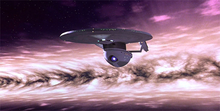Star Trek VI: The Undiscovered Country
Star Trek VI: The Undiscovered Country is a 1991 American science fiction film directed by Nicholas Meyer, who directed the second Star Trek film, The Wrath of Khan. It is the sixth feature film based on the 1966–1969 Star Trek television series. Taking place after the events of Star Trek V: The Final Frontier, it is the final film featuring the entire main cast of the television series. The destruction of the Klingon moon Praxis leads the Klingon Empire to pursue peace with their longtime adversary, the Federation; the crew of the Federation starship USS Enterprise must race against unseen conspirators with a militaristic agenda.
After the critical and commercial disappointment of The Final Frontier, the next film was initially planned as a prequel, with younger actors portraying the crew of the Enterprise while attending Starfleet Academy. The idea was discarded because of negative reaction from the original cast and the fans. Faced with producing a new film in time for Star Trek's 25th anniversary, director Nicholas Meyer and Denny Martin Flinn wrote a script based on a suggestion from Leonard Nimoy about what would happen if "the Wall came down in space", touching on the contemporary events of the Cold War.
Principal photography took place between April and September 1991. Because of a lack of sound stage space on the Paramount lot, many scenes were filmed around Hollywood. Meyer and cinematographer Hiro Narita aimed for a darker and more dramatic mood, altering sets originally used for the television series Star Trek: The Next Generation. Producer Steven-Charles Jaffe led a second unit to an Alaskan glacier that stood in for a Klingon gulag. Cliff Eidelman produced the film's score, which is intentionally darker than previous Star Trek offerings.
Star Trek VI: The Undiscovered Country was released in North America on December 6, 1991. It garnered positive reviews, with publications praising the lighthearted acting, setting and facetious references, and performed strongly at the box office. It posted the largest opening weekend gross of the series before going on to earn $96.8 million worldwide.[3] The film earned two Oscar nominations, for Best Makeup and Best Sound Effects, and is the only Star Trek movie to win the Saturn Award for Best Science Fiction Film. The film has been released on various home media formats, including a special collectors' edition in 2004, to which Meyer made minor alterations to the film.
In 2293, a shock wave strikes the starship USS Excelsior, commanded by Captain Hikaru Sulu, who discovers that Praxis, a Klingon moon, has been destroyed. The loss of Praxis and the destruction of the Klingon homeworld's ozone layer throws the Klingon Empire into turmoil. The Klingons can no longer afford war with the United Federation of Planets, so they pursue peace. Starfleet sends the USS Enterprise-A to meet with the Klingon Chancellor Gorkon and escort him to negotiations on Earth. Captain James T. Kirk, whose son David was murderedby Klingons, opposes conciliation and resents the assignment.




